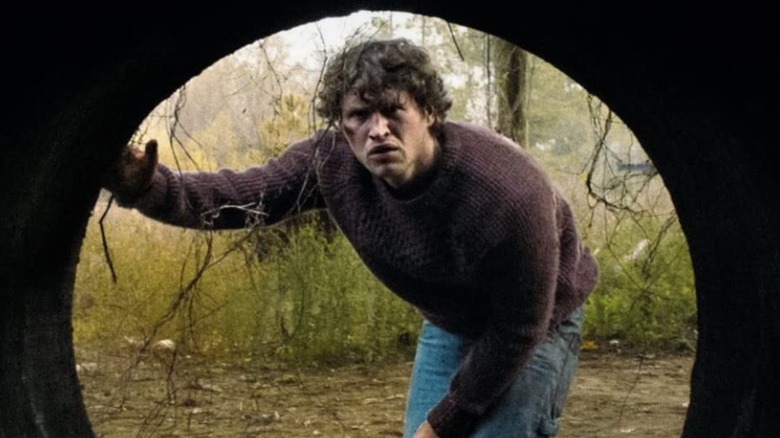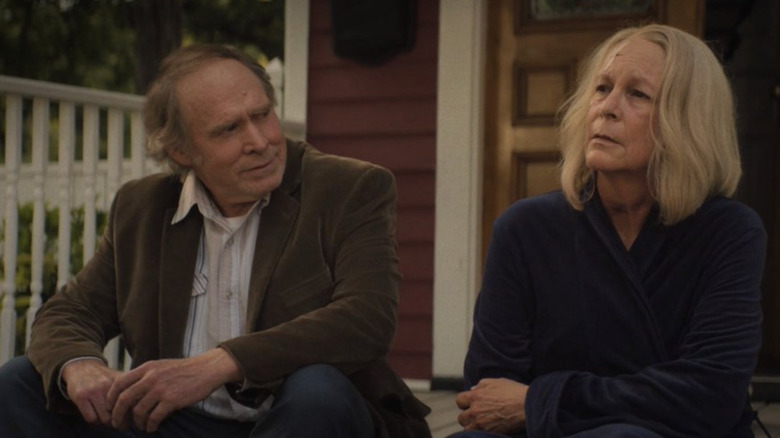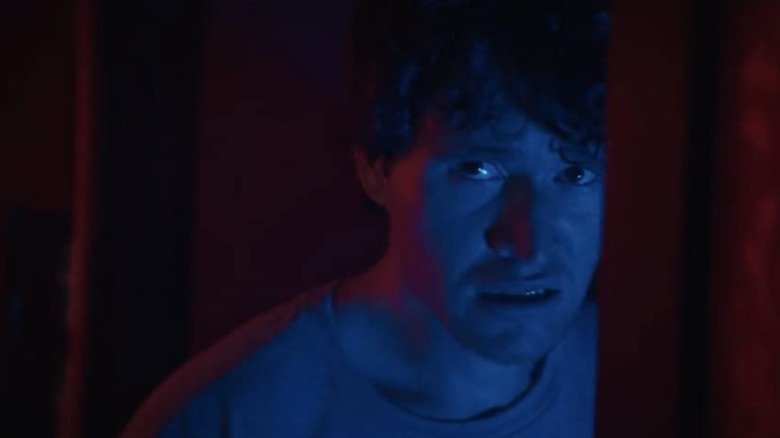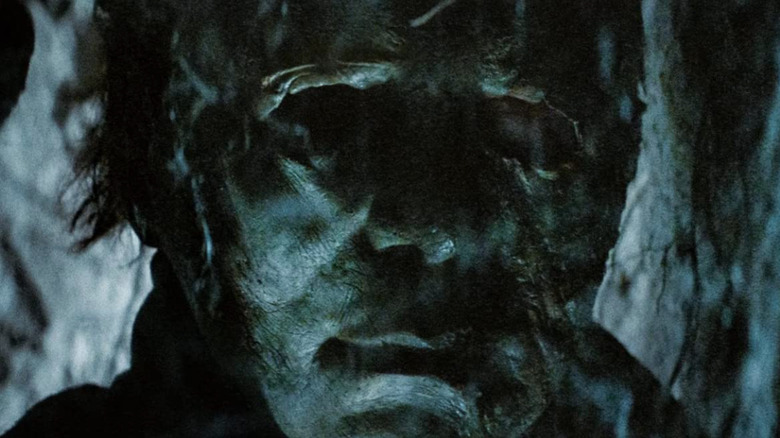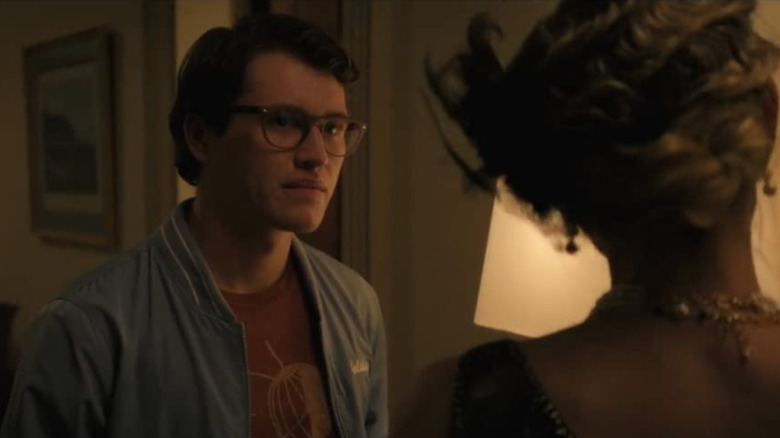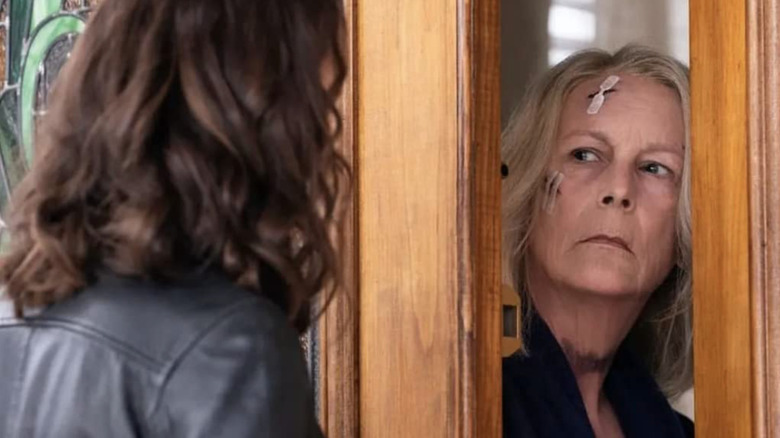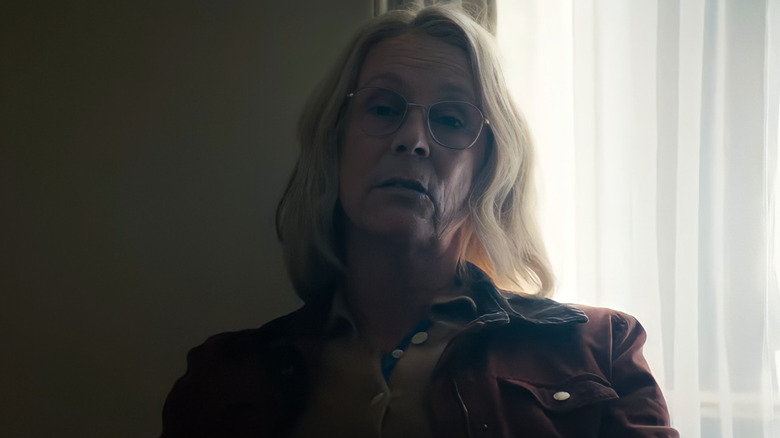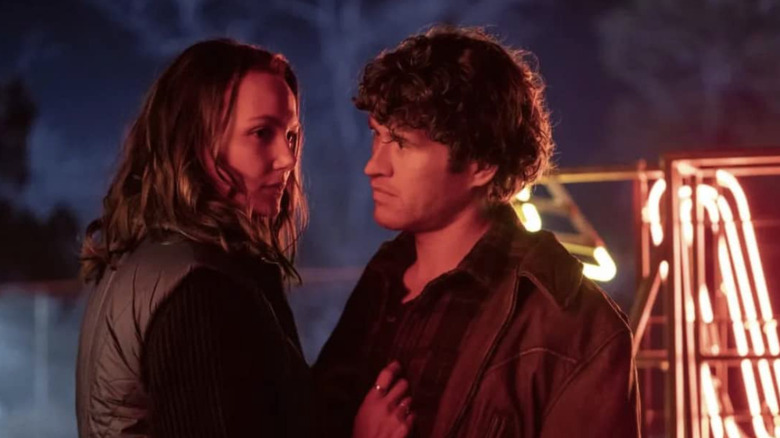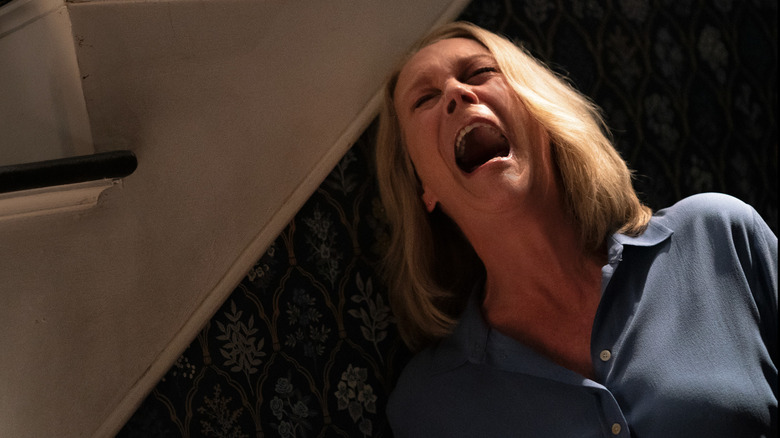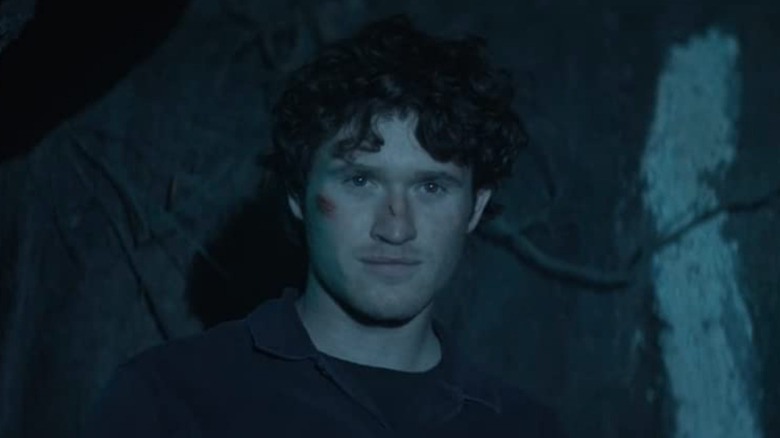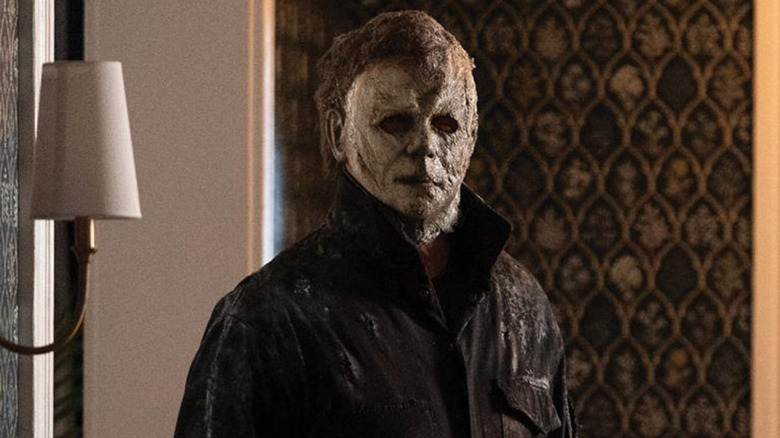10 Moments In Halloween Ends That Make No Sense
After four years and three films, David Gordon Green's "Halloween" sequel trilogy has finally come to an end. One year after Michael's 2018 rampage throughout Haddonfield, Corey Cunningham (Rohan Campbell) is a nice, if slightly nerdy, young man who's babysitting a child named Jeremy (Jaxon Goldenberg). While playing a prank, Jeremy accidentally dies, and the town turns against Corey. With Michael Myers (James Jude Courtney) nowhere to be found, he essentially becomes Haddonfield's new boogeyman. The majority of "Halloween Ends" follows Corey three years later as he struggles to move on with his life. In the week leading up to Halloween, Corey begins a relationship with Laurie Strode's granddaughter, Allyson (Andi Matichak), and runs afoul of Michael Myers, who sends him down a dark path of murder and revenge.
"Halloween Ends" fulfills the promise of its title and provides both a definitive death for Michael and a happy conclusion to Laurie's story. Unfortunately, it does so in the most convoluted way possible. Green takes big creative risks, some of which pay off, but the story is so riddled with plot holes and narrative leaps that it's hard to take anything that happens seriously. Despite the nonsensical plot, however, the film is a lot more fun than it has any right to be — provided you can suspend your disbelief. These 10 nonsensical moments may seem small at first, but as you'll see, they're each indicative of larger issues with the film.
10. Love and vegetables
Laurie Strode (Jamie Lee Curtis) is not the only resident of Haddonfield who's been traumatized by Michael Myers. Frank Hawkins (Will Patton), for example, is a police officer who accidentally killed his partner, then prevented Michael's death, in 1978. He blames himself for Michael's subsequent murders, and is nearly stabbed to death by the Shape on Halloween night in 2018. Frank and Laurie end up sharing a hospital room as they recover from their injuries, and form a bond that seems like it could blossom into love after the dust settles.
However, "Halloween Ends" implies that they've had little to no contact in the four years that followed. Frank and Laurie bump into each other at the grocery store, and Laurie chastises him for the lack of vegetables in his cart. During this interaction, Frank seems to care deeply for Laurie, and it's difficult to believe that he didn't check in on her over the years. They both still live in the same small town, and they both shop at the same grocery store. Is this really the first time they've seen each other since 2018?
"Halloween Ends" has been criticized for focusing on new characters rather than established ones, especially since the film is supposed to serve as a kind of finale for the "Halloween" series. You can see that lack of attention here. It's possible that Laurie's been avoiding Frank because he reminds her of her painful past, but this logic falls apart when we see how much time she spends with Lindsey (Kyle Richards). Given the bond she and Frank share and how excited they are to see each other, there's no way the two wouldn't have been sharing vegetables for the past four years.
9. The worst first date
Trying to break her new beau out of his shell, Allyson invites Corey to a Halloween party at Lindsey's bar. Putting aside the likelihood that either of them would want to celebrate this particular holiday, the end of their first date barely makes sense. Finally letting go for the first time in years, Corey and Allyson tear up the dance floor, hinting at a brighter future for the new couple. Unfortunately, the date takes a turn when Corey bumps into Jeremy's mother. Still grieving, she berates him for having fun, and screams that he is evil, perhaps igniting his murderous rage. Corey scowls at her before running out of the bar, leaving Allyson on the dance floor.
While Mrs. Allen's reaction is understandable, Corey's is not. He turns his frustration on Allyson, claiming that she threw him to the wolves and then abandoned him, when she's clearly done everything she can to ensure that he has a fun night. The incident with Mrs. Allen only occurs because Corey leaves to get another drink.
Allyson's response is equally confusing. She doesn't seem to understand the difference between the residents of Haddonfield seeing her as a survivor and their labeling of Corey as a killer, insisting that they're both just two damaged people who are trying to figure it all out. Corey and Allyson have strong romantic chemistry and quickly make amends. Unfortunately, this confusing first date is a harbinger for things to come. Corey and Allyson's relationship, while fun to watch, feels illogical and is filled with manufactured drama.
8. Killer connection
The Corey who rides his bike to the Allen residence on Halloween night 2019 is a sweet young man who's saving money for college. The Corey we meet three years later has been through the wringer. He's become a local pariah, with many Haddonfield residents refusing to believe that Jeremy's death was an accident. Nearly everyone Corey meets hurls insults at him, demonstrating how much he's hated by the town. Beaten down by this cruelty, he spends his days frustrated and alone.
When an altercation with teen bullies places Corey directly in Michael Myers' path, the aging serial killer notices something familiar in the boy's eyes. Michael lets him go, and the two form a bond that seems to infect Corey with evil. Taking a page out of Michael's playbook, he begins to murder those who have crossed him, from Allyson's cruel colleagues to his overbearing mother.
The question is: Why? Has Michael transferred his murderous spirit into Corey, hoping to thrive in a younger body? Is this a nod to the Curse of Thorn, as explored in "Halloween: The Curse of Michael Myers" in which a series of cursed children must kill to keep the cult alive? The most likely answer, of course, is that Corey simply sees an opportunity to expel the rage he's been suppressing after three years of abuse. If the town already thinks he's the new boogeyman, why not act like it? Unfortunately, his death in the climax leaves us with no clear answers.
7. The new Myers house
Attempting to make amends with Allyson for storming out of Lindsey's Halloween party, Corey invites her to take a walk to the scene of Jeremy's tragic death: the Allen family's beautiful mansion. They're able to walk right into the house, of course, because the building is now deserted. This beautiful home with its four-story spiral staircase is standing vacant; all Corey has to do is crawl through an open window. Even the grand piano is still there, only slightly out of tune.
The Allen home is probably meant to parallel the Myers' house, which was abandoned after Michael's first murder in 1963. However, while both houses hosted horrific tragedies, the two deaths are vastly different. It makes sense that a house in which a six-year-old boy dressed in a clown costume brutally murdered his older sister would develop a sinister reputation. However, Jeremy's death was an accident. They're not comparable events at all, and as an attempt to cast Corey as Michael's peer, drawing parallels between the two houses falls flat.
It's also difficult to believe that the Allens would simply discard such an expensive home. "Halloween Kills" showed us that even the Myers house was renovated and sold. The vacant Allen house offers Corey a convenient place to rest and brood between killings, but the logic behind its abandonment doesn't hold up to scrutiny.
6. Laurie the Freakshow
In some of the most maddening scenes in "Halloween Ends," the residents of Haddonfield blame Laurie for Michael's crimes. The sister of Michael's victim claims that Laurie "provoked that man when [she] should have left him alone." The smug local DJ says she "teased a man with brain damage, and then he snapped."
What world are these people living in? Green's "Halloween" shows Laurie preparing for Michael's return in hopes of killing him one day, but Michael himself is totally unaware of this. He only learns about Laurie's vendetta against him when he returns and tries to murder her. It's possible that Haddonfield's residents are referring to the vigilantes who hunt Michael through town and attack him in the street, but that mob is clearly organized and led by Tommy Doyle (Anthony Michael Hall).
Further, Laurie is hospitalized and has no contact with Michael after he breaks into her house and stabs her. Thematically, "Halloween Ends" seems to be arguing that everyone who encounters Michael Myers is corrupted by the association. However, it's handled in such a clunky fashion that it feels more like victim blaming, and it's very frustrating. Laurie has already been through enough to convince us that she's traumatized; watching her deal with abuse from the townsfolk in addition to everything else feels cruel and unnecessary.
5. Disappearing Laurie
In order to sell Corey as the "New Michael," Green needs to establish a grudge between Corey and Laurie, a tall order considering that she's just set him up with Allyson. Having slept in the Allen mansion, Corey awakens on the morning of Halloween to a rhythmic tapping. Laurie is there, waiting to confront Corey about his relationship with her granddaughter. Fearing for his sanity, she wants Corey to leave Allyson alone. It's an understandable concern, but this conversation unfolds with an almost comical lack of coherence.
Laurie waxes poetic about the two different kinds of evil, and claims to want to help Corey, then orders him to stay away from her granddaughter. With the intensity ratcheted up to 11, Corey blames Laurie for the misery in Allyson's life and issues an ominous warning: If he can't have her, no one will. However, as Corey monologues about Laurie's secret desire for death, he realizes the chair is now empty. Was Laurie really there, or was this just an example of Corey's loosening grip on reality?
The more important question, however, is what does any of this mean? In the space of one scene, Laurie goes from an overprotective grandmother to a warrior battling a murderer for Allyson's soul. Corey becomes convinced that Laurie wants to kill him, a massive leap from simply wanting him to break up with Allyson. The conversation is a messy jumble of shocking statements, and rushes a conflict that should take much longer to build.
4. The new Laurie loves the new Michael
When Corey and Allyson first meet, she has an instant attraction to him that he doesn't seem to share. In fact, he half-heartedly rejects her advances until he finds himself in Michael's clutches. This connection with evil seemingly awakens a desire for Allyson; he quickly becomes obsessed with her, and is determined to wrestle her affections away from her grandmother, Laurie. Allyson feels the intensity of their bond, too, and makes plans to leave town with a boyfriend she's known for less than a week.
As two attractive young people, it's understandable that Corey and Allyson would forge a romantic connection. By trying to fix Corey, Allyson can distract herself from her own pain. Corey also looks quite a bit like her dead boyfriend, Cameron (Dylan Arnold). For Corey's part, he can hardly be blamed for wanting to be with the only girl in town who treats him with kindness. As such, it's not the facts of the relationship that feel odd. It's how brightly their passion burns, especially given the timeline. Sometimes, it seems like Corey's descent into evil is driving him towards Allyson, and sometimes it seems like she's the only bulwark against his murderous thoughts.
Allyson's obnoxious colleague says that her relationship with Corey is like what would've happened if Laurie had fallen in love with Michael in 1978. That sets up an interesting thought experiment, but there's not nearly enough time in "Halloween Ends" to delve into this intriguing dynamic, and their relationship rapidly intensifies in ways that feel forced and unlikely. After everything the two Strode women have been through together, it's hard to believe that Allyson would turn against her grandmother in favor of a boy she just met.
3. Suicide showdown
After their confrontation in the Allen mansion, Corey decides that Laurie wants to kill him, and makes plans to leave town with Allyson. However, this seems to be a distraction designed to get her out of the house, as Corey then goes on a murder spree that he hopes will end with Laurie's death. In anticipation, Laurie lures Corey to her office by staging her own suicide, then shoots Corey and knocks him over the banister. While it certainly provided for a suspenseful trailer and the fall neatly recalls Jeremy's death, this makes absolutely no sense. Wouldn't Laurie's suicide solve Corey's problems without requiring him to get his hands dirty? The entire thing seems designed to make the audience think that Laurie might die by suicide, and to recreate the triumphant "Gotcha" moment from Green's "Halloween."
Laurie empties her gun and challenges Corey to try and kill her. Hearing Allyson coming, Corey repeats, "If I can't have her...," then stabs the knife into his own throat. Perhaps he sees no way out of his current predicament, and knows that the best way to hurt Laurie is to turn Allyson against her. Perhaps he wants someone else to know the pain of being mistaken for a murderer. But why would he sacrifice his life for this? What should be an unforgettable climax unravels into a series of illogical moments that seem designed purely to shock.
If you or anyone you know is having suicidal thoughts, please call the National Suicide Prevention Lifeline by dialing 988 or by calling 1-800-273-TALK (8255).
2. Tag team killers
After the bullies toss him over the side of a bridge — people fall from high places a lot in "Halloween Ends" — Corey appears to be dead. When he's pulled into Michael's sewer dwelling, we assume that, even if he managed to survive the fall, he won't live for long. Surprisingly, though, Michael sits in the shadows and lets Corey sleep it off. He awakens and shares a moment of intense eye contact with Michael, which sets him on a dark path that will end with his own death. Thus, Corey becomes a student of the Shape, luring a potential victim to the sewer and demanding that Michael show him how to kill.
As Corey's need to kill increases, the infection in his hand spreads. At one point, Corey extends his palm toward the murder, appearing to absorb Michael's power through his stitches. Corey seems to be asking Michael for permission to exercise his rage at the citizens of Haddonfield, but what's in this for Mr. Myers? What does he see in Corey, and why does he let the man survive? Are the two working together, or is Michael simply living vicariously through a younger model? And after four years of hiding, why is Michael suddenly thirsty for blood again, anyway?
The entire interaction between the two killers is probably intended to be a passing of the torch moment that cements Corey's status as Haddonfield's new boogeyman. The story also hints at a powerful metaphor for cancel culture, and a possible commentary on the power of redemption. The execution of all of this is clumsy and poorly thought out, though. Like so much of "Halloween Ends," giving these moments a little more time to breathe would clear up the confusion, offer more room to fully explore these compelling ideas, and ensure that they have the impact they're supposed to.
1. Wasted potential
If the relationship between Michael and Corey feels confusing, the conclusion of their story boggles the mind. After Corey stabs himself on Laurie's floor, Michael emerges from the shadows, intent on finishing her off. As he passes Corey, the young man grabs Michael's foot. Michael responds by breaking Corey's neck. Why? Neither of their motives make any sense. Corey just tried to kill Laurie. Why would he want to stop Michael from completing the job? And why would Michael want to kill the one person who shares his evil intentions?
The simple explanation is that Michael is a murderer and Corey is a body in his way; alternatively, maybe he's angry that Corey stole his mask and wants revenge. The larger, and more pertinent, question is why director David Gordon Green sacrificed Corey for a cheap scare and robbed himself of a compelling new story? So much of the film is spent setting up Corey as the new Michael, but the final act cuts this promising thread short. Green delivers a definitive end to a decades-long struggle between Michael and Laurie, but this could've been accomplished with Corey surviving to kill another day. The opening title cards even use the infamous "Halloween III: Season of the Witch" font, implying the beginning of a new story. Why did Green spend so much time developing a promising new character, only to throw him away in the end?
